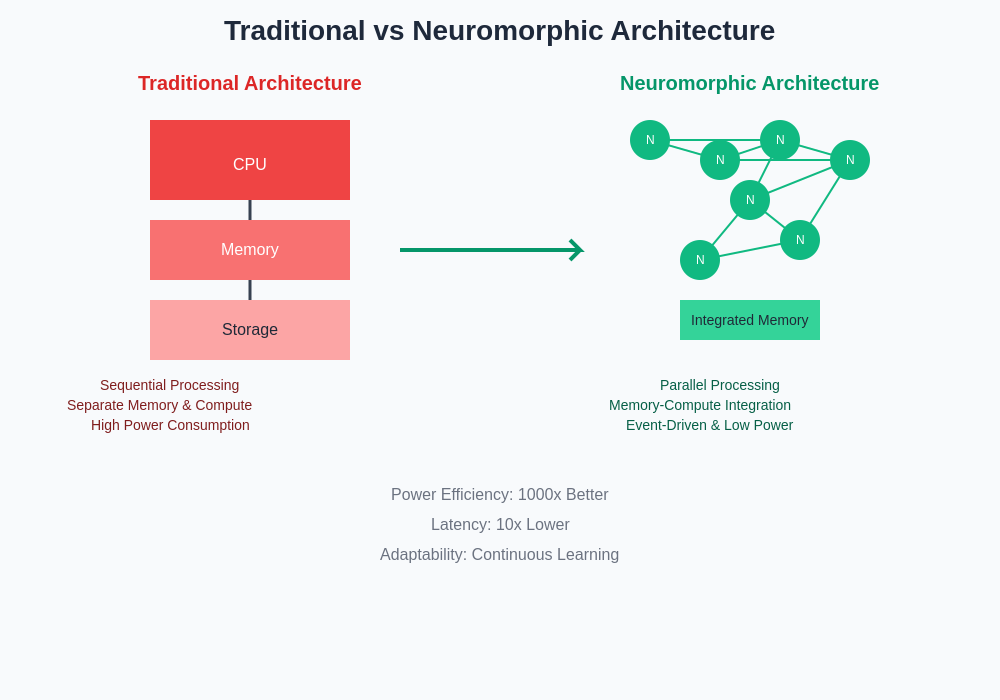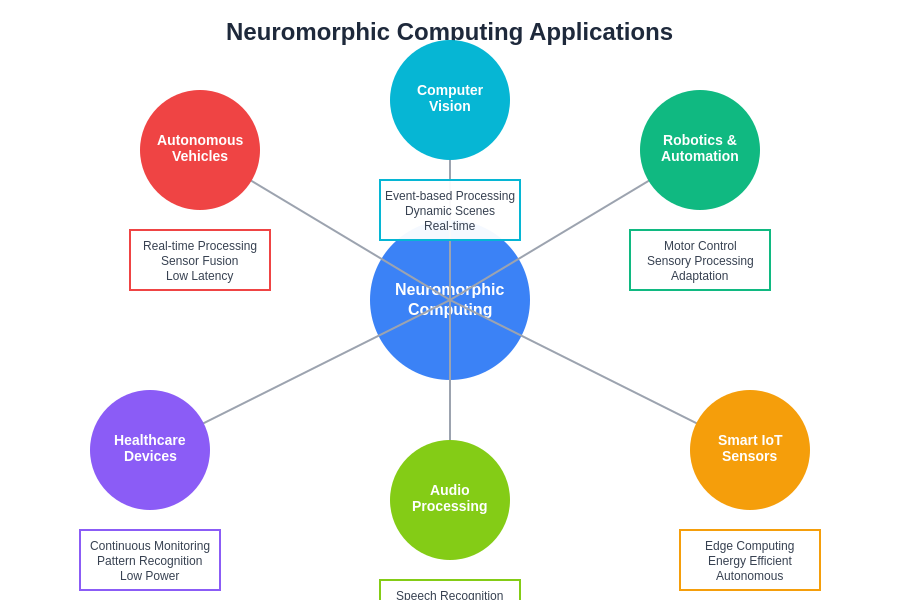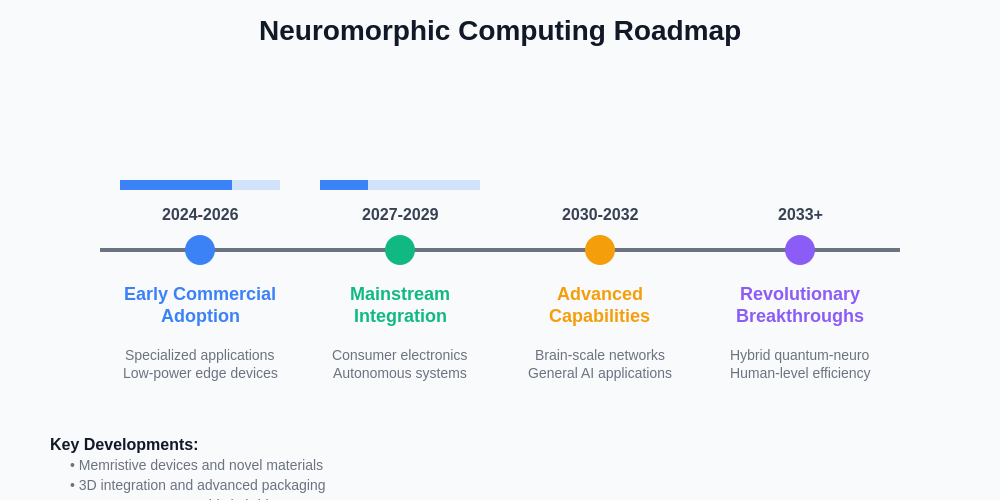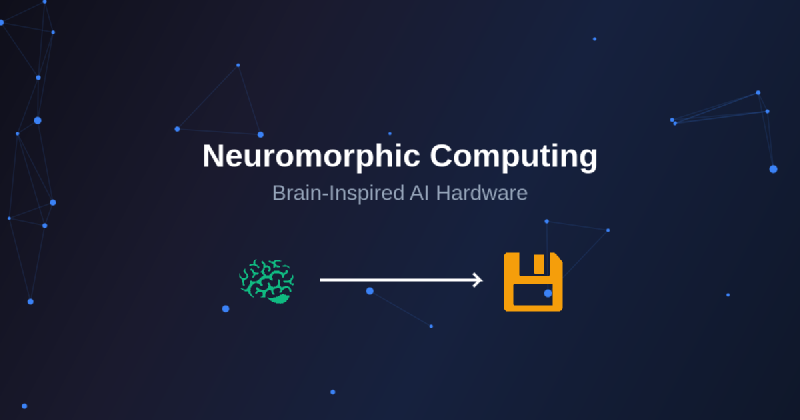The convergence of neuroscience and computer science has birthed one of the most revolutionary computing paradigms of our time: neuromorphic computing. This groundbreaking approach to artificial intelligence hardware design draws direct inspiration from the intricate neural networks of the human brain, promising to unlock unprecedented levels of computational efficiency, adaptability, and intelligence. As traditional computing architectures struggle to keep pace with the exponential demands of modern AI applications, neuromorphic systems emerge as a transformative solution that could fundamentally reshape how we process information and interact with intelligent machines.
Explore the latest developments in AI hardware to understand how neuromorphic computing is revolutionizing the landscape of artificial intelligence and computational efficiency. The biological inspiration behind these systems represents more than just an engineering curiosity; it embodies a paradigm shift that could solve some of the most pressing challenges in contemporary computing, from energy consumption to real-time processing capabilities.
Understanding the Biological Foundation
The human brain represents the pinnacle of computational efficiency, processing vast amounts of information while consuming merely twenty watts of power—equivalent to a dim light bulb. This remarkable efficiency stems from the brain’s unique architecture, where billions of neurons communicate through electrical and chemical signals in a massively parallel, event-driven manner. Unlike traditional digital computers that process information sequentially and synchronously, the brain operates asynchronously, with neurons firing only when stimulated by specific input patterns or threshold conditions.
Neuromorphic computing seeks to replicate these fundamental principles through specialized hardware architectures that mimic the brain’s neural networks. These systems implement artificial neurons and synapses using electronic circuits that can process information in ways that closely resemble biological neural activity. The result is computing hardware that exhibits brain-like characteristics such as adaptability, fault tolerance, low power consumption, and the ability to learn and process information in real-time.
The philosophical implications of brain-inspired computing extend beyond mere technical considerations. By studying and replicating the mechanisms that enable human intelligence, neuromorphic systems provide insights into the fundamental nature of cognition and consciousness while simultaneously advancing our capabilities in artificial intelligence. This bidirectional relationship between neuroscience and computing has accelerated discoveries in both fields, creating a synergistic cycle of innovation that continues to push the boundaries of what is possible in computational intelligence.
Architectural Innovations in Neuromorphic Systems
Traditional computing architectures rely on the von Neumann model, where processing units and memory are physically separated, requiring constant data movement between components. This separation creates bottlenecks that limit computational efficiency and increase energy consumption, particularly in AI applications that require extensive parallel processing. Neuromorphic systems fundamentally challenge this paradigm by implementing architectures where computation and memory are co-located, mimicking the brain’s integrated approach to information processing.
Experience advanced AI capabilities with Claude to understand how brain-inspired computing principles are being integrated into modern AI systems for enhanced reasoning and learning capabilities. The architectural innovations in neuromorphic computing encompass several key design principles that differentiate these systems from conventional digital computers.
Spiking neural networks form the computational foundation of neuromorphic systems, utilizing discrete events called spikes to communicate information between artificial neurons. These spikes occur only when specific threshold conditions are met, ensuring that processing resources are utilized only when necessary. This event-driven approach dramatically reduces power consumption compared to traditional systems that continuously process data regardless of whether meaningful computation is occurring.
The integration of memory and processing elements in neuromorphic architectures eliminates the need for separate memory hierarchies and reduces the energy overhead associated with data movement. Artificial synapses store connection weights and modify their values based on learning rules, enabling the system to adapt and improve performance over time. This plasticity allows neuromorphic systems to learn from experience and adjust their behavior in response to changing conditions or new information.

The architectural flexibility of neuromorphic systems enables them to support various learning paradigms, from supervised learning with labeled datasets to unsupervised learning that discovers patterns in unlabeled data. Reinforcement learning capabilities allow these systems to improve performance through interaction with their environment, making them particularly well-suited for applications that require autonomous decision-making and adaptation.
Energy Efficiency and Power Consumption Advantages
One of the most compelling advantages of neuromorphic computing lies in its exceptional energy efficiency, which addresses one of the most significant challenges facing modern computing systems. Traditional AI applications, particularly deep learning models, require enormous computational resources and consume substantial amounts of energy during both training and inference phases. Large language models and computer vision systems can consume megawatts of power, making them environmentally unsustainable and economically prohibitive for many applications.
Neuromorphic systems achieve dramatic energy savings through several innovative mechanisms that mirror the brain’s efficient information processing strategies. Event-driven computation ensures that artificial neurons consume power only when processing relevant information, eliminating the constant energy drain associated with clock-synchronized digital systems. This approach can reduce energy consumption by several orders of magnitude compared to traditional processors performing equivalent computational tasks.
The sparse activation patterns characteristic of neuromorphic systems contribute significantly to their energy efficiency. Unlike conventional neural networks where all neurons are activated during each computation cycle, neuromorphic networks activate only the subset of neurons relevant to processing specific input patterns. This selective activation dramatically reduces the overall power requirements while maintaining computational accuracy and performance.
Analog and mixed-signal processing capabilities in neuromorphic chips enable direct manipulation of continuous signals without the energy overhead associated with analog-to-digital conversion processes. These capabilities are particularly valuable for sensor integration applications where real-world signals can be processed directly without intermediate conversion steps, further enhancing overall system efficiency.
The implications of these energy efficiency improvements extend far beyond cost savings. Low-power neuromorphic systems enable the deployment of intelligent processing capabilities in battery-powered devices, remote sensors, and embedded systems where traditional AI hardware would be impractical. This capability opens new possibilities for ubiquitous intelligence in Internet of Things applications, autonomous vehicles, and portable devices that require extended operational lifetimes.
Real-Time Processing and Latency Optimization
Traditional computing systems face significant challenges when processing real-time data streams, particularly in applications that require immediate responses to dynamic environmental conditions. The sequential nature of conventional processors and the overhead associated with data movement between memory and processing units create latencies that can be problematic for time-critical applications such as autonomous navigation, robotics control, and real-time signal processing.
Neuromorphic systems excel in real-time processing scenarios due to their inherently parallel and asynchronous operation modes. Unlike traditional systems that must complete entire computational cycles before producing outputs, neuromorphic processors can generate responses immediately upon detecting relevant input patterns or reaching decision thresholds. This capability enables ultra-low latency processing that is essential for applications requiring instantaneous reactions to changing conditions.
Discover comprehensive AI research capabilities with Perplexity to explore the latest developments in real-time AI processing and neuromorphic computing applications. The temporal dynamics inherent in spiking neural networks provide natural mechanisms for processing time-varying signals and implementing temporal memory without requiring explicit clock synchronization or complex timing circuits.
The distributed processing architecture of neuromorphic systems enables multiple computational tasks to proceed simultaneously without interfering with each other. This parallelism is particularly advantageous for applications that must process multiple data streams concurrently, such as multi-sensor fusion in autonomous systems or simultaneous pattern recognition across different input modalities.
Adaptive processing capabilities allow neuromorphic systems to adjust their computational priorities dynamically based on input characteristics and environmental demands. This flexibility ensures that critical information receives immediate attention while less urgent data can be processed with lower priority, optimizing overall system responsiveness and resource utilization.
Learning and Adaptation Mechanisms
The ability to learn and adapt represents one of the most significant advantages of neuromorphic computing systems over traditional digital architectures. Biological neural networks continuously modify their synaptic connections based on experience, enabling organisms to learn new skills, adapt to changing environments, and improve performance over time. Neuromorphic systems implement similar plasticity mechanisms that allow artificial neural networks to evolve and optimize their behavior through various learning paradigms.
Spike-timing-dependent plasticity serves as a fundamental learning mechanism in neuromorphic systems, modifying synaptic strengths based on the precise timing of neural activities. This temporal learning rule enables the system to discover and reinforce causal relationships between input patterns and desired outputs, facilitating the development of complex behavioral responses without explicit programming.
Online learning capabilities distinguish neuromorphic systems from traditional AI architectures that typically require separate training and deployment phases. Neuromorphic processors can continue learning and adapting during operation, enabling them to handle novel situations and gradually improve performance based on accumulated experience. This continuous learning capability is particularly valuable for applications in dynamic environments where conditions may change over time.
The hierarchical organization of neuromorphic networks enables multi-level learning, where different layers of the system can specialize in processing information at different abstraction levels. Lower layers might focus on detecting basic features or patterns, while higher layers integrate these features into more complex representations and decision-making processes. This hierarchical learning structure mirrors the organization of biological neural systems and enables efficient processing of complex, multi-dimensional data.
Unsupervised learning capabilities allow neuromorphic systems to discover patterns and structures in data without requiring labeled training examples. This capability is particularly valuable for applications where obtaining labeled data is expensive or impractical, and it enables systems to develop internal representations that capture the underlying structure of their input environment.
Applications in Sensory Processing and Robotics
Neuromorphic computing has found particularly promising applications in sensory processing and robotics, where the brain-inspired architecture provides natural advantages for handling real-world data streams and controlling complex mechanical systems. The event-driven nature of neuromorphic processors aligns well with the temporal dynamics of sensory information, enabling more efficient and responsive processing of visual, auditory, and tactile inputs.
Computer vision applications benefit significantly from neuromorphic processing approaches that can handle dynamic visual scenes with minimal computational overhead. Traditional computer vision systems must process entire image frames at regular intervals, regardless of whether significant changes have occurred in the scene. Neuromorphic vision sensors, in contrast, generate events only when pixel intensities change, dramatically reducing data volumes and processing requirements while maintaining high temporal resolution.
Auditory processing applications leverage the temporal processing capabilities of spiking neural networks to implement sophisticated sound recognition and localization systems. The ability to process time-varying acoustic signals directly, without intermediate spectral analysis steps, enables more efficient and accurate processing of speech, music, and environmental sounds. These capabilities are particularly valuable for hearing aid applications, voice recognition systems, and autonomous navigation based on acoustic cues.
Robotics applications represent one of the most promising domains for neuromorphic computing, where the combination of sensory processing, motor control, and adaptive learning capabilities can be integrated into unified control systems. The low latency and real-time processing capabilities of neuromorphic systems enable robots to respond quickly to environmental changes, while adaptive learning mechanisms allow them to improve performance through experience and interaction with their surroundings.
Tactile sensing and haptic feedback systems benefit from the continuous-time processing capabilities of neuromorphic architectures, which can handle the complex temporal dynamics associated with touch and force sensing. This capability enables more sophisticated manipulation tasks and provides the foundation for advanced prosthetic devices that can provide natural sensory feedback to users.

The integration of neuromorphic processing with advanced sensor technologies creates opportunities for developing intelligent sensing systems that can operate autonomously in complex environments. These systems can adapt to changing conditions, learn from experience, and provide high-level interpretation of sensory data without requiring external computational resources.
Challenges and Technical Limitations
Despite the promising capabilities of neuromorphic computing, several significant challenges and technical limitations continue to constrain the widespread adoption and development of these systems. The inherently analog nature of many neuromorphic implementations introduces variability and noise that can affect computational accuracy and reliability. Unlike digital systems where bit-level precision can be guaranteed, neuromorphic processors must contend with device variations, temperature effects, and aging phenomena that can alter circuit behavior over time.
Programming and software development for neuromorphic systems presents unique challenges that differ substantially from traditional digital computing paradigms. The event-driven, asynchronous nature of neuromorphic processors requires new programming models and development tools that can effectively express temporal dynamics and spike-based communication patterns. The lack of standardized programming frameworks and development environments has slowed the adoption of neuromorphic computing in mainstream applications.
Scalability concerns arise when attempting to implement large-scale neural networks on neuromorphic hardware. While individual neuromorphic chips can efficiently implement relatively small neural networks, scaling to the massive parameter counts required for modern AI applications presents significant technical and economic challenges. The interconnection complexity and communication overhead associated with large-scale neuromorphic systems remain active areas of research and development.
Integration with existing computing infrastructure represents another significant challenge for neuromorphic systems. Most software applications and data processing pipelines are designed for traditional digital computers, making it difficult to incorporate neuromorphic processors without substantial system redesign. The development of interface standards and middleware solutions that can bridge between neuromorphic and conventional computing systems is essential for broader adoption.
Manufacturing complexity and cost considerations limit the commercial viability of neuromorphic processors, particularly for applications that do not require the unique advantages these systems provide. The specialized fabrication processes and novel device structures required for neuromorphic implementations often result in higher manufacturing costs compared to conventional digital processors, limiting their economic competitiveness in cost-sensitive applications.
Commercial Development and Industry Applications
The commercial development of neuromorphic computing has gained significant momentum in recent years, with major technology companies, research institutions, and startups investing substantial resources in advancing this technology from laboratory prototypes to viable commercial products. Intel’s Loihi chip, IBM’s TrueNorth processor, and various academic research projects have demonstrated the feasibility of implementing neuromorphic principles in practical hardware systems that can address real-world computational challenges.
Industry applications are emerging across diverse sectors where the unique advantages of neuromorphic computing provide compelling value propositions. Autonomous vehicle systems benefit from the real-time processing capabilities and energy efficiency of neuromorphic processors, which can handle sensor fusion, obstacle detection, and path planning tasks with minimal latency and power consumption. The ability to continue learning and adapting during operation enables these systems to improve performance based on accumulated driving experience.
Healthcare applications leverage neuromorphic computing for medical device development, particularly in areas requiring continuous monitoring and real-time analysis of physiological signals. Neuromorphic processors can implement sophisticated pattern recognition algorithms for detecting cardiac arrhythmias, seizure activity, or other medical conditions while consuming minimal power and operating for extended periods on battery power.
Industrial automation and process control systems are adopting neuromorphic computing for applications requiring adaptive control, predictive maintenance, and quality assurance. The ability to learn normal operating patterns and detect anomalies in real-time makes neuromorphic systems valuable for monitoring complex industrial processes and equipment performance.
Smart city and Internet of Things applications utilize neuromorphic computing for distributed intelligence in sensor networks, environmental monitoring, and infrastructure management. The low power consumption and autonomous learning capabilities of neuromorphic processors enable the deployment of intelligent sensors that can operate independently for extended periods while providing sophisticated data analysis and decision-making capabilities.
Future Directions and Emerging Technologies
The future development of neuromorphic computing is being shaped by advances in multiple technological domains that promise to enhance the capabilities and expand the applications of brain-inspired computing systems. Emerging memory technologies, including memristive devices, phase-change materials, and novel semiconductor structures, are enabling the development of more sophisticated artificial synapses that can store and modify connection weights with greater precision and efficiency.
Three-dimensional integration technologies are enabling the development of neuromorphic processors with unprecedented connectivity and computational density. These advanced packaging and integration techniques allow multiple layers of neural processing circuits to be stacked and interconnected, creating architectures that more closely resemble the three-dimensional organization of biological neural networks.
The integration of neuromorphic computing with quantum computing technologies represents an exciting frontier that could unlock entirely new computational paradigms. Quantum-inspired neural networks and hybrid quantum-neuromorphic systems are being explored for their potential to solve optimization problems and implement learning algorithms that are intractable on conventional computing systems.
Advanced materials research is contributing to the development of neuromorphic devices with improved performance characteristics and new functional capabilities. Organic semiconductor materials, carbon nanotube devices, and novel nanostructured materials are being investigated for their potential to implement more efficient and versatile artificial neurons and synapses.

The convergence of neuromorphic computing with other emerging technologies, including artificial intelligence, robotics, and biotechnology, is creating opportunities for developing systems that exhibit unprecedented levels of intelligence, adaptability, and autonomy. These hybrid systems could eventually lead to artificial intelligence that approaches or exceeds human-level cognitive capabilities while maintaining the energy efficiency and robustness characteristic of biological neural systems.
Machine learning techniques are being applied to optimize neuromorphic system design and operation, creating self-improving architectures that can automatically adjust their configuration and parameters to maximize performance for specific applications. This meta-learning capability could enable neuromorphic systems to adapt not only their computational behavior but also their underlying hardware characteristics to optimize efficiency and accuracy.
Impact on Artificial Intelligence Evolution
Neuromorphic computing represents a fundamental shift in how we approach artificial intelligence development, moving beyond the limitations of traditional digital architectures toward more biologically-inspired and inherently intelligent hardware systems. This transition has profound implications for the future evolution of AI technology, potentially enabling the development of artificial intelligence systems that exhibit characteristics previously thought to require human-level cognition.
The energy efficiency advantages of neuromorphic computing could democratize access to advanced AI capabilities by making sophisticated intelligence affordable and practical for a much broader range of applications. Instead of requiring massive data centers and substantial power infrastructure, neuromorphic AI systems could operate effectively on battery power in portable devices, remote sensors, and embedded applications.
The real-time learning and adaptation capabilities inherent in neuromorphic systems could enable the development of AI that continuously improves and evolves throughout its operational lifetime. Unlike current AI systems that are trained once and deployed with fixed capabilities, neuromorphic AI could adapt to new situations, learn from mistakes, and develop new skills based on accumulated experience.
The integration of sensory processing and cognitive functions in unified neuromorphic architectures could lead to more holistic and intuitive AI systems that can understand and interact with the world in ways that more closely resemble human intelligence. These systems could potentially develop common sense reasoning, emotional understanding, and creative problem-solving capabilities that remain challenging for traditional AI approaches.
The distributed and fault-tolerant nature of neuromorphic systems could enable the development of AI that is more robust and reliable than current digital implementations. The graceful degradation characteristics of brain-inspired architectures mean that these systems can continue operating effectively even when individual components fail, providing the reliability needed for critical applications in healthcare, transportation, and defense.
Conclusion and Strategic Implications
Neuromorphic computing represents one of the most promising pathways toward achieving truly intelligent and efficient artificial intelligence systems that can operate seamlessly in the real world. By drawing inspiration from the fundamental principles of biological neural networks, these brain-inspired architectures offer solutions to some of the most pressing challenges in contemporary computing, including energy consumption, real-time processing requirements, and adaptive learning capabilities.
The strategic implications of neuromorphic computing extend across multiple industries and application domains, potentially reshaping how we approach problems in artificial intelligence, robotics, healthcare, autonomous systems, and human-computer interaction. Organizations that invest in understanding and developing neuromorphic computing capabilities today will be better positioned to leverage these technologies as they mature and become commercially viable.
The continued advancement of neuromorphic computing will require sustained collaboration between neuroscientists, computer scientists, materials researchers, and engineers to overcome the remaining technical challenges and unlock the full potential of brain-inspired computing. The interdisciplinary nature of this field ensures that progress will continue to benefit both our understanding of biological intelligence and our ability to create artificial systems that exhibit similar capabilities.
As neuromorphic computing technologies continue to evolve and mature, they promise to usher in a new era of artificial intelligence that is more efficient, adaptable, and capable than anything we have achieved with traditional digital computing approaches. The future of intelligent systems lies not in simply scaling up existing architectures, but in fundamentally reimagining how we process information and implement intelligence in artificial systems.
The journey toward realizing the full potential of neuromorphic computing is still in its early stages, but the progress achieved thus far provides compelling evidence that brain-inspired approaches to artificial intelligence represent a viable and promising path forward. As we continue to unlock the secrets of biological intelligence and translate these insights into artificial systems, neuromorphic computing will play an increasingly important role in shaping the future of technology and human-machine interaction.
Disclaimer
This article is for informational purposes only and does not constitute professional advice. The views expressed are based on current understanding of neuromorphic computing technologies and their potential applications. Readers should conduct their own research and consider their specific requirements when evaluating neuromorphic computing solutions. The field of neuromorphic computing is rapidly evolving, and specific technical details or commercial availability may change as the technology continues to develop.
